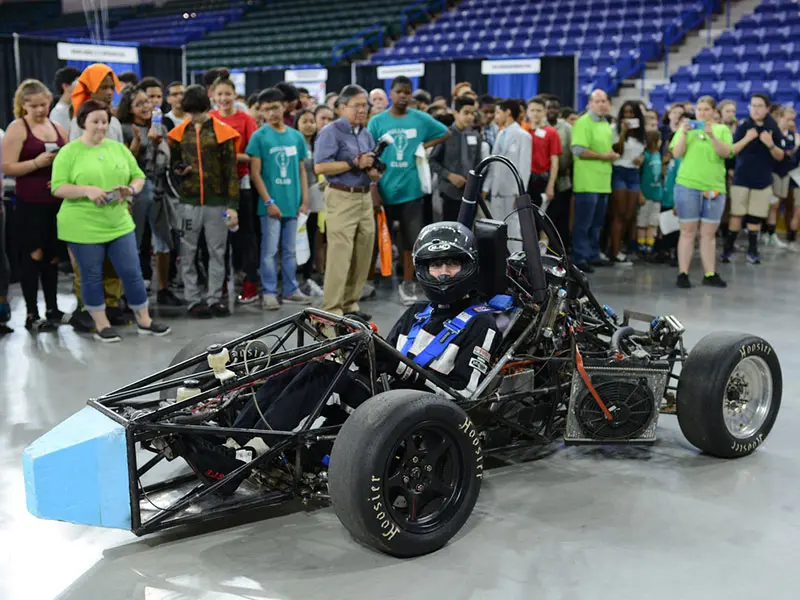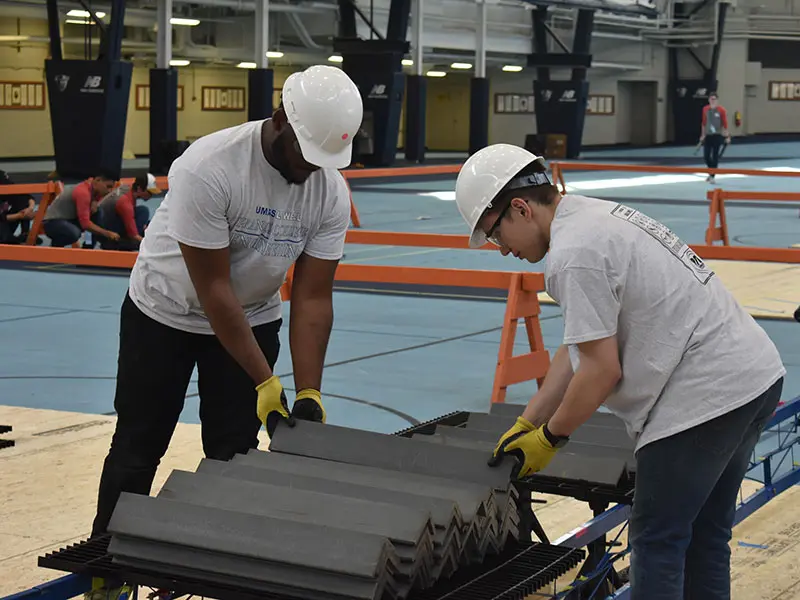From Rockets and Planes to Concrete Canoes, Steel Bridges and Race Cars, Engineering Competitions Give Student Clubs a Chance to Shine

Senior mechanical engineering major Luis Meyer, vice president of the UML Rocketry Club, holds the Astrohawk rocket before last fall’s test launch in St. Albans, Vt
03/23/2020
By Ed Brennen
On a picture-perfect fall day last October, a half-dozen students from the Francis College of Engineering gathered on a patch of farmland in St. Albans, Vermont, a small town about 10 miles shy of the Canadian border on the shores of Lake Champlain.
The students, all members of the UML Rocketry Club, didn’t make the five-hour drive for leaf peeping or pumpkin picking, however. They came to St. Albans to test-launch one of their rockets, Astrohawk, in preparation for the annual Spaceport America Cup, an intercollegiate rocket engineering competition to be held in New Mexico.
“We’re definitely excited to be accepted, especially since it’s our first time applying for it,” says the club’s president, Benjamin Lamen, a senior mechanical engineering major from Northborough, Mass. “This will be our first big competition.”
It was going to be their first big competition—until it was canceled like almost every other big event across the country this spring because of the coronavirus pandemic.
The Rocketry Club is one of several student organizations from the Francis College that had planned to take part in regional and national competitions this spring.
The Design, Build, Fly club was constructing an unmanned, radio-controlled airplane that was to take to the skies at an international event in Wichita, Kan., April 16-19. That same weekend, the Concrete Canoe and Steel Bridge teams were supposed to compete in separate events at Norwich University in Northfield, Vt.
River Hawk Racing, which took a hiatus from competitions this year, is gearing up for future events hosted by the Society of Automotive Engineers.
“It would have been a blast representing the school,” says Steel Bridge president Dale Gable, a senior civil engineering major from Arlington, Mass., who joined the club last year because he says it was a “golden opportunity” to gain hands-on experience that potential employers will be seeking.

The River Hawk Racing club’s Formula SAE race car turns heads at a community event at the Tsongas Center.
“The best thing I’ve experienced is the variety of people I work with,” says River Hawk Racing President Nour Khreim, a senior mechanical engineering major from Amman, Jordan. “I’ve met great people here at the university and have made strong connections.”
But engineering clubs that participate in annual competitions offer students something more. For seniors, the rockets, planes, canoes, bridges and cars they build can serve as their Industrial Capstone Senior Design projects. And for all club members, working together toward a year-end competition that’s circled in bright red on the calendar teaches them real-world project management skills that cannot be replicated in coursework.
“You really get an idea of what a big project like this actually takes compared to something you do as part of a class,” says Design, Build, Fly President Sean Roche, a senior mechanical engineering major from Leominster, Mass.
Flight Check
Ever since their proposal to the American Institute of Aeronautics and Astronautics was accepted in October, Roche and his fellow club members were busy preparing for the Cessna/Raytheon Missile Systems Student Design/Build/Fly competition in Wichita. They met weekly in the Lawrence Lin MakerSpace to carefully plan and fabricate the various components of their balsa wood airplane, which could have a wingspan of up to 5 feet.

Senior mechanical engineering majors, from left, Brett Wadman, Ben Francoeur and Sean Roche hold the partially constructed plane they had planned to enter in the Cessna/Raytheon Missile Systems Student Design/Build/Fly competition in Wichita, Kan.
While students frequently use SolidWorks to design 3D models in class, Roche says there is a special satisfaction in using the program to design a plane and then seeing the parts fit together perfectly.
“It’s a lot more fun with this kind of project,” says Roche, a licensed pilot who inherited a love of flying from his parents. He’s happy to have found students at UML who share his passion.
“This is something that we chose to do because we’re interested in it,” says Roche, whose balsa wood plane was to fly three missions at the competition: one with no payload, one with simulated passengers and luggage, and one with a deployable banner. Their banner would read “UMass Lowell,” of course.
Mixing It Up
At the Falmouth Annex on North Campus, in a former Facilities Management garage, the Concrete Canoe team was hard at work developing the right concrete mix for this year’s 20-foot-long, 200-pound floating feat of engineering. The organization that runs the annual canoe race, the American Society of Civil Engineers (ASCE), tweaks the rules each year to force teams to innovate. This year’s rules stated that teams could not use latex in their mix.
“Latex helps us create Play-Doh-like concrete, so we struggled a lot trying to create the same consistency without it,” says team project manager Kat Evasius, a senior civil and environmental engineering major from Worcester, Mass., who joined the club as a freshman.
Evasius worked as a construction intern for the Massachusetts Department of Transportation (Mass- DOT) the past two summers and will begin a full-time position with the state agency after Commencement— something she credits to her Concrete Canoe team experience.
“We definitely have a leg up in the workforce,” says Evasius, who has applied many of the skills she’s learned with the club (like testing methods, estimating and project management) to her work with MassDOT. “Being able to relate them to real life is really beneficial.”

Concrete Canoe team members launch their boat, Vitruvius, during last year’s competition in Orono, Maine.
“Being in this club gets you in a lot of doors,” says Federiconi, a junior civil engineering major from Medford, Mass. Besides making professional connections with Concrete Canoe alumni, Federiconi says having the team on her résumé is an instant conversation starter in interviews for internships and co-ops.
“The first question people ask is, ‘Does it actually float?’ Then I can go into how we make it float and how it differs from concrete you see on the sidewalks,” Federiconi says. “It’s a great talking point.”
Once the team perfected its concrete mix, students placed the concrete on their canoe mold and let it cure for 28 days. The process takes place inside an enclosed tent that feels like a tropical rainforest; overhead nozzles spray a constant mist into the air, which reaches 99 percent relative humidity.
The finished canoe, which the team named “Pathfinder,” was to race in five events at the ASCE New England regionals in Northfield: women’s and men’s sprints, women’s and men’s slaloms, and a co-ed race.
UML’s Concrete Canoe team has a proud tradition of success at the annual competitions, including several trips to the national finals and multiple top-three finishes at the New England regionals. The River Hawks finished a disappointing fourth at last year’s regional after being disqualified from a race because of a missed buoy.
“We were looking forward to redeeming ourselves this year,” Federiconi says.
Steely Determination
The Steel Bridge team was to travel with the Concrete Canoe team to Northfield for its New England Student Steel Bridge Competition regional event, hosted by the American Institute of Steel Construction (AISC). At the competition, teams must assemble their prefabricated steel sections into a scale model of a bridge that can support 2,500 pounds while meeting size and weight specifications.

The Steel Bridge team competes.
“It’s a lot more involved than in the past, and I think we’re better for it,” says Gable, whose club has been working on its bridge design since October. “The fabrication is where you get all the strength in your joints. We think about those connections now when we design things, and whether or not the bridge is constructible and how easy it will be to get the pieces machined the way we want.”
Final Countdown
As the model rocket competitions approached, the work ramped up for the UML Rocketry Club members. There were progress reports to submit to event organizers, travel arrangements to be made and funding to be secured from the Office of Student Activities and Leadership and other sources like the Dean’s Office.
On a Wednesday night in late February, the MakerSpace was abuzz with student activity. At one table, a half-dozen of the Rocketry Club’s 30 members had their laptops flipped open and were discussing the various subsystems of their rocket.
The Spaceport America Cup, which is run by the Experimental Sounding Rocket Association, features two levels of competition: one that sends rockets up 10,000 feet and another to 30,000 feet. The River Hawks were to compete in the 10,000-foot category.
“Before we started looking for competitions, the club was more engineering student enthusiasts who wanted to build rockets,” says Lamen, who plans to work in the aerospace industry after completing his degree next fall, perhaps at Raytheon Technologies, where he has already worked as an information intelligence systems intern.
Not all of the club’s members are aspiring rocket scientists, however. The club’s treasurer, Jaki Giggi, is a junior computer engineering major from Medfield, Mass., who was pulled in by her roommate as a freshman.
“I thought it was out of my league,” says Giggi, who has worked as a systems analyst co-op at Bose and Dell EMC and hopes to go into the field of embedded design and microprocessors. “I’d never had any experience with aerospace or rocketry.”
Now, she is the electronics lead for the subsystem that provides all the telemetry data for the rocket’s altitude, velocity, acceleration and general pressure sensors.
“I’ve gained a lot of practical knowledge with reading sensor data,” says Giggi.
“I’m glad I joined the club,” she says. “Once I joined, everyone was really accepting. I didn’t need to know any of the specifics about rockets. Everyone helps teach you along the way.”
